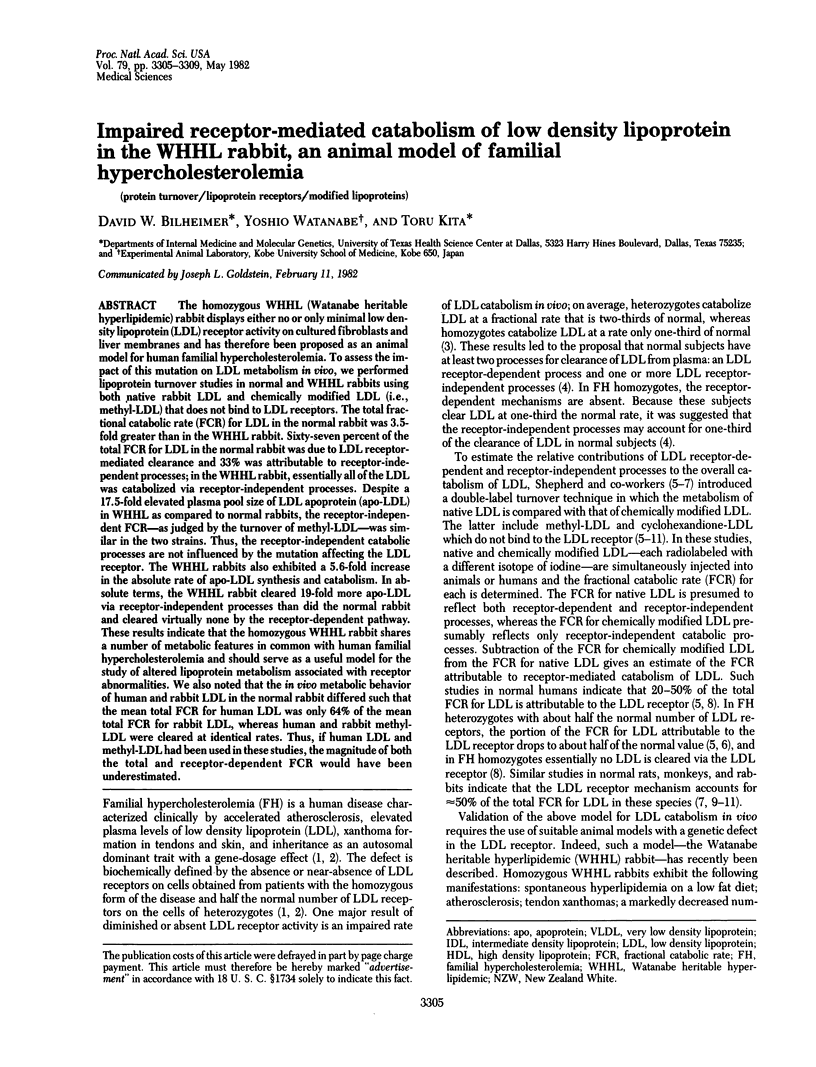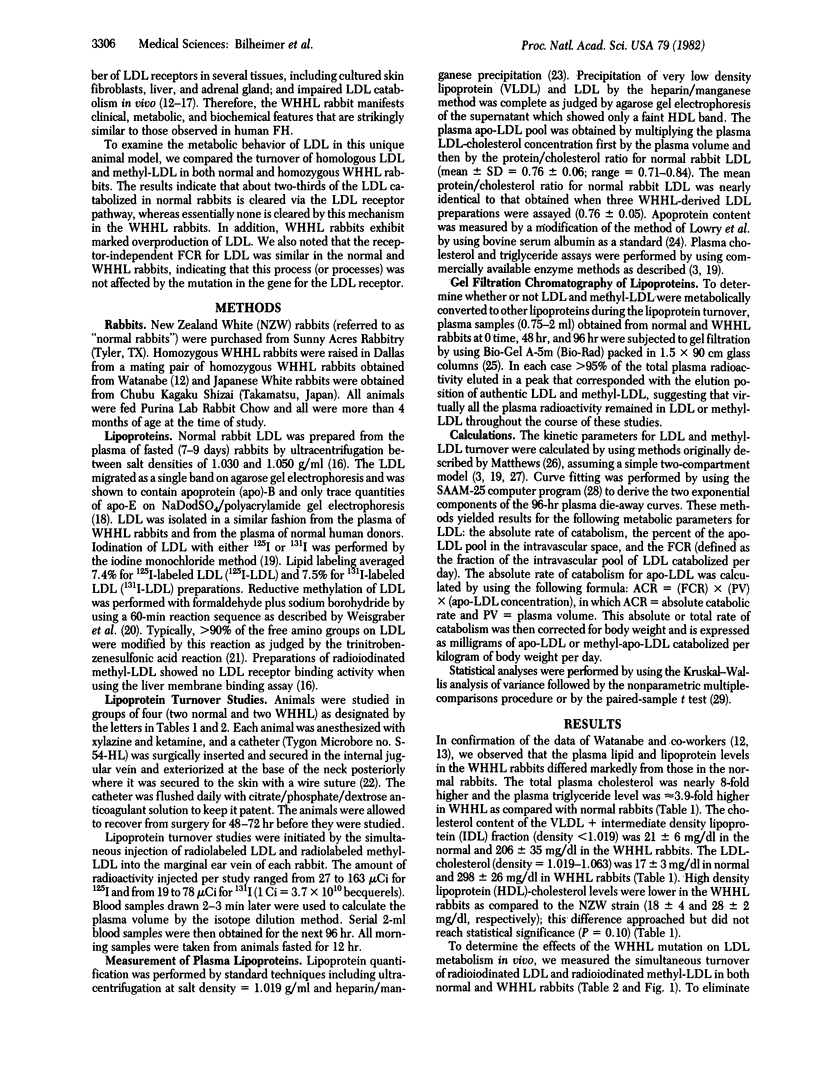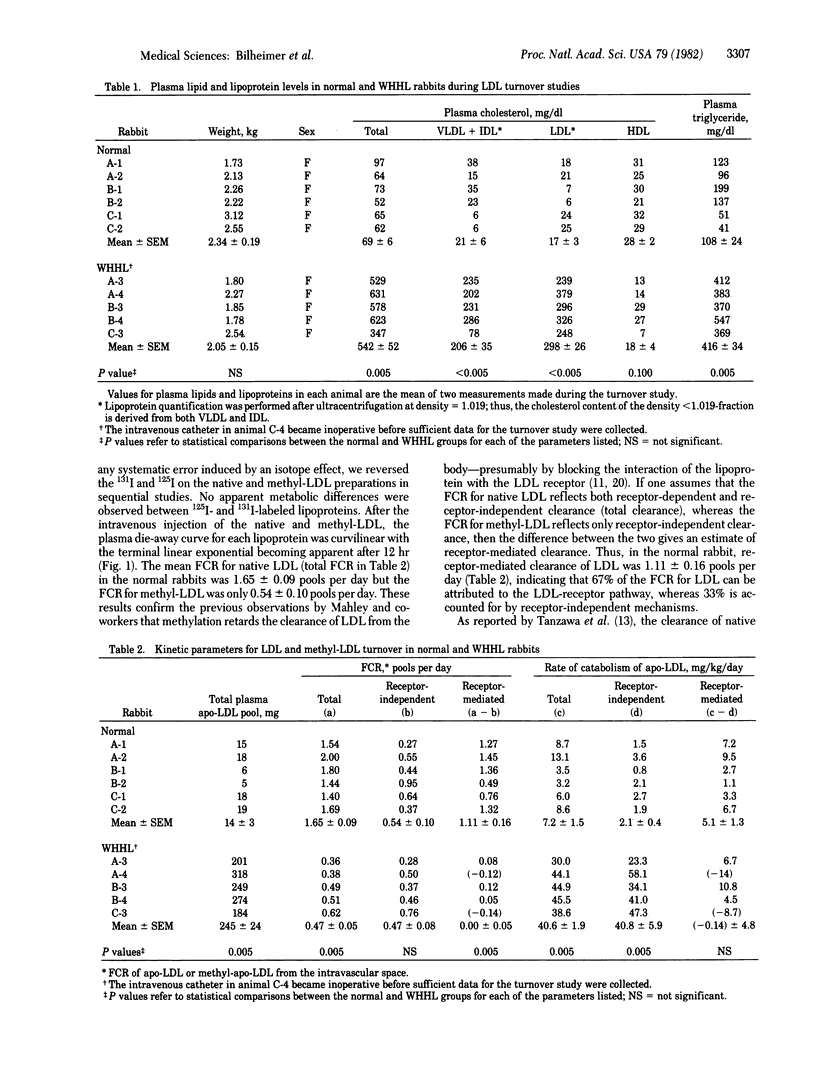Abstract
The homozygous WHHL (Watanabe heritable hyperlipidemic) rabbit displays either no or only minimal low density lipoprotein (LDL) receptor activity on cultured fibroblasts and liver membranes and has therefore been proposed as an animal model for human familial hypercholesterolemia. To assess the impact of this mutation on LDL metabolism in vivo, we performed lipoprotein turnover studies in normal and WHHL rabbits using both native rabbit LDL and chemically modified LDL (i.e., methyl-LDL) that does not bind to LDL receptors. The total fractional catabolic rate (FCR) for LDL in the normal rabbit was 3.5-fold greater than in the WHHL rabbit. Sixty-seven percent of the total FCR for LDL in the normal rabbit was due to LDL receptor-mediated clearance and 33% was attributable to receptor-independent processes; in the WHHL rabbit, essentially all of the LDL was catabolized via receptor-independent processes. Despite a 17.5-fold elevated plasma pool size of LDL apoprotein (apo-LDL) in WHHL as compared to normal rabbits, the receptor-independent FCR—as judged by the turnover of methyl-LDL—was similar in the two strains. Thus, the receptor-independent catabolic processes are not influenced by the mutation affecting the LDL receptor. The WHHL rabbits also exhibited a 5.6-fold increase in the absolute rate of apo-LDL synthesis and catabolism. In absolute terms, the WHHL rabbit cleared 19-fold more apo-LDL via receptor-independent processes than did the normal rabbit and cleared virtually none by the receptor-dependent pathway. These results indicate that the homozygous WHHL rabbit shares a number of metabolic features in common with human familial hypercholesterolemia and should serve as a useful model for the study of altered lipoprotein metabolism associated with receptor abnormalities. We also noted that the in vivo metabolic behavior of human and rabbit LDL in the normal rabbit differed such that the mean total FCR for human LDL was only 64% of the mean total FCR for rabbit LDL, whereas human and rabbit methyl-LDL were cleared at identical rates. Thus, if human LDL and methyl-LDL had been used in these studies, the magnitude of both the total and receptor-dependent FCR would have been underestimated.
Keywords: protein turnover, lipoprotein receptors, modified lipoproteins
Full text
PDF




Selected References
These references are in PubMed. This may not be the complete list of references from this article.
- Attie A. D., Pittman R. C., Watanabe Y., Steinberg D. Low density lipoprotein receptor deficiency in cultured hepatocytes of the WHHL rabbit. Further evidence of two pathways for catabolism of exogenous proteins. J Biol Chem. 1981 Oct 10;256(19):9789–9792. [PubMed] [Google Scholar]
- Berman M. Kinetic analysis of turnover data. Prog Biochem Pharmacol. 1979;15:67–108. [PubMed] [Google Scholar]
- Bilheimer D. W., Goldstein J. L., Grundy S. M., Brown M. S. Reduction in cholesterol and low density lipoprotein synthesis after portacaval shunt surgery in a patient with homozygous familial hypercholesterolemia. J Clin Invest. 1975 Dec;56(6):1420–1430. doi: 10.1172/JCI108223. [DOI] [PMC free article] [PubMed] [Google Scholar]
- Bilheimer D. W., Stone N. J., Grundy S. M. Metabolic studies in familial hypercholesterolemia. Evidence for a gene-dosage effect in vivo. J Clin Invest. 1979 Aug;64(2):524–533. doi: 10.1172/JCI109490. [DOI] [PMC free article] [PubMed] [Google Scholar]
- Goldstein J. L., Brown M. S. Atherosclerosis: the low-density lipoprotein receptor hypothesis. Metabolism. 1977 Nov;26(11):1257–1275. doi: 10.1016/0026-0495(77)90119-6. [DOI] [PubMed] [Google Scholar]
- Goldstein J. L., Brown M. S. The LDL receptor locus and the genetics of familial hypercholesterolemia. Annu Rev Genet. 1979;13:259–289. doi: 10.1146/annurev.ge.13.120179.001355. [DOI] [PubMed] [Google Scholar]
- Goldstein J. L., Brown M. S. The low-density lipoprotein pathway and its relation to atherosclerosis. Annu Rev Biochem. 1977;46:897–930. doi: 10.1146/annurev.bi.46.070177.004341. [DOI] [PubMed] [Google Scholar]
- Habeeb A. F. Determination of free amino groups in proteins by trinitrobenzenesulfonic acid. Anal Biochem. 1966 Mar;14(3):328–336. doi: 10.1016/0003-2697(66)90275-2. [DOI] [PubMed] [Google Scholar]
- Kita T., Brown M. S., Watanabe Y., Goldstein J. L. Deficiency of low density lipoprotein receptors in liver and adrenal gland of the WHHL rabbit, an animal model of familial hypercholesterolemia. Proc Natl Acad Sci U S A. 1981 Apr;78(4):2268–2272. doi: 10.1073/pnas.78.4.2268. [DOI] [PMC free article] [PubMed] [Google Scholar]
- Kovanen P. T., Schneider W. J., Hillman G. M., Goldstein J. L., Brown M. S. Separate mechanisms for the uptake of high and low density lipoproteins by mouse adrenal gland in vivo. J Biol Chem. 1979 Jun 25;254(12):5498–5505. [PubMed] [Google Scholar]
- LOWRY O. H., ROSEBROUGH N. J., FARR A. L., RANDALL R. J. Protein measurement with the Folin phenol reagent. J Biol Chem. 1951 Nov;193(1):265–275. [PubMed] [Google Scholar]
- Langer T., Strober W., Levy R. I. The metabolism of low density lipoprotein in familial type II hyperlipoproteinemia. J Clin Invest. 1972 Jun;51(6):1528–1536. doi: 10.1172/JCI106949. [DOI] [PMC free article] [PubMed] [Google Scholar]
- MATTHEWS C. M. The theory of tracer experiments with 131I-labelled plasma proteins. Phys Med Biol. 1957 Jul;2(1):36–53. doi: 10.1088/0031-9155/2/1/305. [DOI] [PubMed] [Google Scholar]
- Mahley R. W., Innerarity T. L., Weisgraber K. B., Oh S. Y. Altered metabolism (in vivo and in vitro) of plasma lipoproteins after selective chemical modification of lysine residues of the apoproteins. J Clin Invest. 1979 Sep;64(3):743–750. doi: 10.1172/JCI109518. [DOI] [PMC free article] [PubMed] [Google Scholar]
- Mahley R. W., Weisgraber K. H., Innerarity T. L., Windmueller H. G. Accelerated clearance of low-density and high-density lipoproteins and retarded clearance of E apoprotein-containing lipoproteins from the plasma of rats after modification of lysine residues. Proc Natl Acad Sci U S A. 1979 Apr;76(4):1746–1750. doi: 10.1073/pnas.76.4.1746. [DOI] [PMC free article] [PubMed] [Google Scholar]
- Mahley R. W., Weisgraber K. H., Melchior G. W., Innerarity T. L., Holcombe K. S. Inhibition of receptor-mediated clearance of lysine and arginine-modified lipoproteins from the plasma of rats and monkeys. Proc Natl Acad Sci U S A. 1980 Jan;77(1):225–229. doi: 10.1073/pnas.77.1.225. [DOI] [PMC free article] [PubMed] [Google Scholar]
- Rudel L. L., Lee J. A., Morris M. D., Felts J. M. Characterization of plasma lipoproteins separated and purified by agarose-column chromatography. Biochem J. 1974 Apr;139(1):89–95. doi: 10.1042/bj1390089. [DOI] [PMC free article] [PubMed] [Google Scholar]
- Shepherd J., Bicker S., Lorimer A. R., Packard C. J. Receptor-mediated low density lipoprotein catabolism in man. J Lipid Res. 1979 Nov;20(8):999–1006. [PubMed] [Google Scholar]
- Shepherd J., Packard C. J., Bicker S., Lawrie T. D., Morgan H. G. Cholestyramine promotes receptor-mediated low-density-lipoprotein catabolism. N Engl J Med. 1980 May 29;302(22):1219–1222. doi: 10.1056/NEJM198005293022202. [DOI] [PubMed] [Google Scholar]
- Shimada Y., Tanzawa K., Kuroda M., Tsujita Y., Arai M., Watanabe Y. Biochemical characterization of skin fibroblasts derived from WHHL-rabbit, a notable animal model for familial hypercholesterolemia. Eur J Biochem. 1981 Sep 1;118(3):557–564. doi: 10.1111/j.1432-1033.1981.tb05555.x. [DOI] [PubMed] [Google Scholar]
- Slater H. R., Packard C. J., Bicker S., Shepherd J. Effects of cholestyramine on receptor-mediated plasma clearance and tissue uptake of human low density lipoproteins in the rabbit. J Biol Chem. 1980 Nov 10;255(21):10210–10213. [PubMed] [Google Scholar]
- Tanzawa K., Shimada Y., Kuroda M., Tsujita Y., Arai M., Watanabe H. WHHL-rabbit: a low density lipoprotein receptor-deficient animal model for familial hypercholesterolemia. FEBS Lett. 1980 Aug 25;118(1):81–84. doi: 10.1016/0014-5793(80)81223-3. [DOI] [PubMed] [Google Scholar]
- Thompson G. R., Soutar A. K., Spengel F. A., Jadhav A., Gavigan S. J., Myant N. B. Defects of receptor-mediated low density lipoprotein catabolism in homozygous familial hypercholesterolemia and hypothyroidism in vivo. Proc Natl Acad Sci U S A. 1981 Apr;78(4):2591–2595. doi: 10.1073/pnas.78.4.2591. [DOI] [PMC free article] [PubMed] [Google Scholar]
- Watanabe Y., Ito T., Saeki M., Kuroda M., Tanzawa K., Mochizuki M., Tsujita Y., Arai M. Hypolipidemic effects of CS-500 (ML-236B) in WHHL-rabbit, a heritable animal model for hyperlipidemia. Atherosclerosis. 1981 Jan-Feb;38(1-2):27–31. doi: 10.1016/0021-9150(81)90100-3. [DOI] [PubMed] [Google Scholar]
- Watanabe Y. Serial inbreeding of rabbits with hereditary hyperlipidemia (WHHL-rabbit). Atherosclerosis. 1980 Jun;36(2):261–268. doi: 10.1016/0021-9150(80)90234-8. [DOI] [PubMed] [Google Scholar]
- Weisgraber K. H., Innerarity T. L., Mahley R. W. Role of lysine residues of plasma lipoproteins in high affinity binding to cell surface receptors on human fibroblasts. J Biol Chem. 1978 Dec 25;253(24):9053–9062. [PubMed] [Google Scholar]


